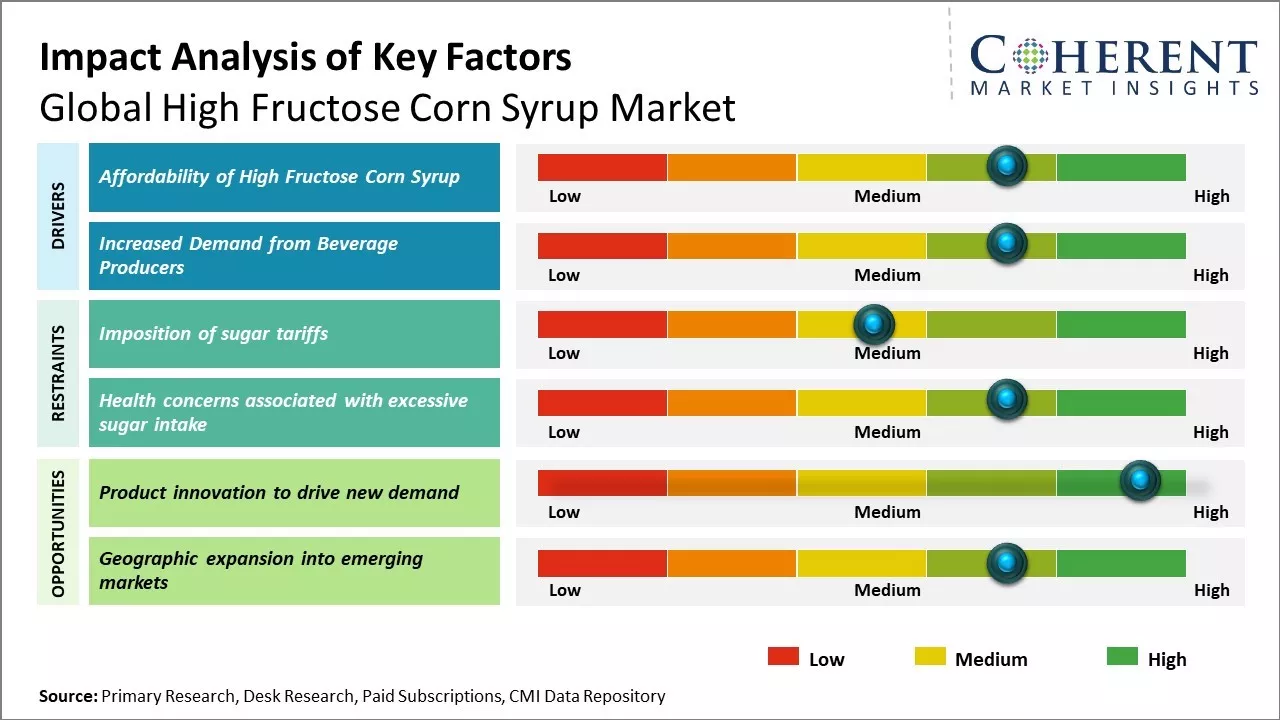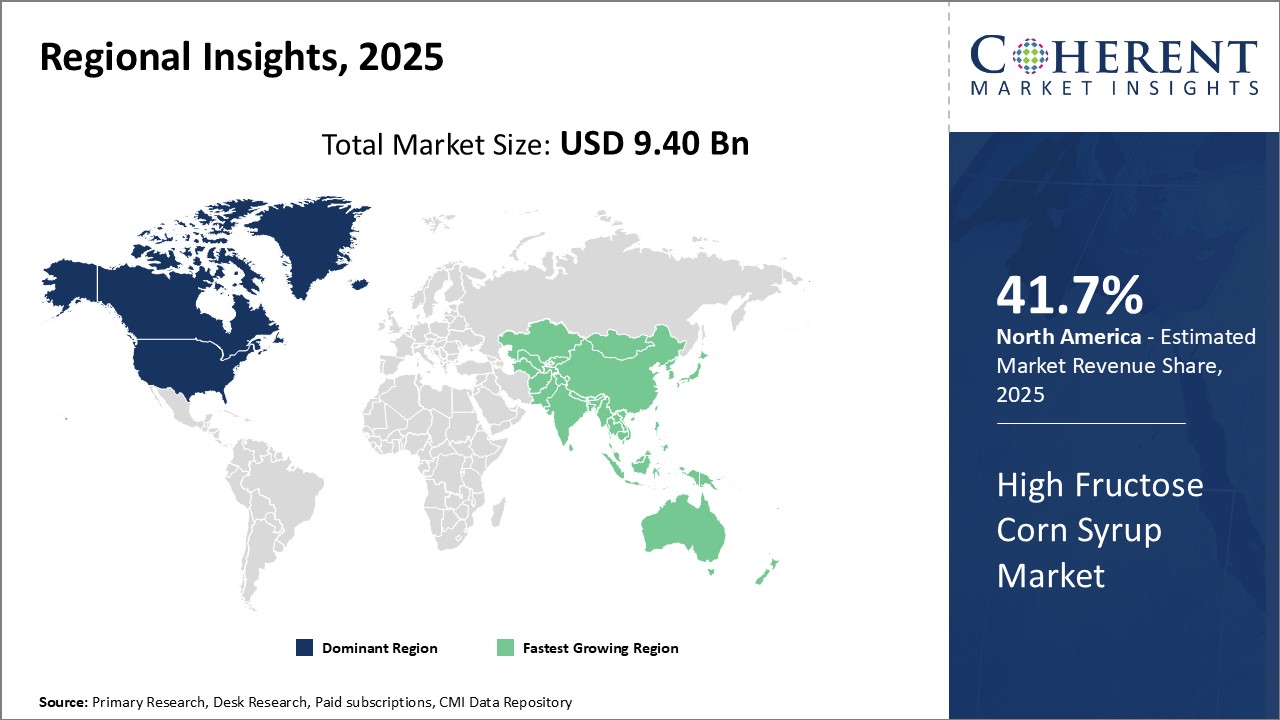The high fructose corn syrup market is estimated to be valued at USD 9.40 Bn in 2025 and is expected to reach USD 10.80 Bn by 2032, exhibiting a compound annual growth rate (CAGR) of 2.0% from 2025 to 2032.

To learn more about this report, Download Free Sample
The global High Fructose Corn Syrup (HFCS) Market is experiencing steady growth, driven by its widespread adoption in the food and beverage industry as a cost-effective and versatile sweetener. HFCS—produced from corn starch through enzymatic conversion—offers several advantages over traditional sugar, including improved stability, longer shelf life, and ease of incorporation into various formulations. These characteristics have made HFCS, particularly HFCS 55, a preferred ingredient in the production of soft drinks, baked goods, and processed foods.
|
Current Event |
Description and its impact |
|
Shift in Consumer Preferences Toward Natural Sweeteners |
|
|
Regulatory Developments and Labeling Requirements |
|
|
Innovation in HFCS Formulations and Applications |
|
Uncover macros and micros vetted on 75+ parameters: Get instant access to report
The pricing of high fructose corn syrup (HFCS) is closely tied to raw material costs, primarily corn, along with energy prices and production efficiency. Fluctuations in corn harvest yields, weather conditions, and global trade policies significantly impact HFCS pricing trends. HFCS 55 and HFCS 42 are the most commercially used variants, with prices varying slightly based on fructose concentration and end-use applications.
North America, particularly the U.S., benefits from abundant corn supplies and advanced refining infrastructure, resulting in relatively stable and competitive pricing. In contrast, regions that rely on imports, such as Europe and parts of Asia, often face higher prices due to tariffs, transportation costs, and local regulations. Additionally, demand from food and beverage sectors plays a key role in price dynamics, especially during peak seasons. While HFCS remains cost-effective compared to traditional sugar, rising health awareness and regulatory pressures may influence future pricing and demand stability.
Artificial Intelligence (AI) is playing an increasingly significant role in optimizing operations across the High Fructose Corn Syrup (HFCS) market. In production, AI-driven systems enhance efficiency by monitoring and adjusting variables in real-time, such as temperature, enzyme activity, and conversion rates, leading to higher yields and consistent quality.
Predictive analytics helps manufacturers anticipate demand fluctuations, optimize inventory management, and reduce waste. In supply chain operations, AI streamlines logistics and procurement by forecasting corn prices and identifying cost-saving opportunities. Moreover, AI is used in product development to analyze consumer preferences and health trends, supporting the creation of reformulated HFCS-based products with improved nutritional profiles.
Marketing teams leverage AI tools to track market sentiment and tailor campaigns accordingly. As health regulations tighten and demand evolves, AI provides a competitive edge by enabling data-driven decisions, enhancing sustainability efforts, and ensuring adaptability in a dynamic and cost-sensitive sweetener market.
The rising global demand for organic and vegan food is influencing consumer preferences and reshaping the high fructose corn syrup (HFCS) market. Health-conscious consumers increasingly seek natural, minimally processed ingredients, viewing HFCS as a synthetic additive due to its industrial manufacturing process.
As a result, food producers catering to organic and vegan segments are moving away from HFCS, opting for alternatives like organic cane sugar, agave syrup, or fruit-based sweeteners. Certification requirements for organic and vegan labeling often exclude HFCS, further limiting its use in such product lines. This shift is particularly evident in developed markets like North America and Europe, where clean-label and plant-based diets are gaining traction.
Although HFCS remains dominant in conventional food processing due to its low cost and functional properties, its role is being challenged by the growing emphasis on ingredient transparency, natural sourcing, and consumer demand for healthier, ethical food choices.
High fructose corn syrup has provided extensive cost benefits for food and beverage manufacturers over the years. Producing high fructose corn syrup requires relatively simple processing of corn when compared to cane and beet sugars. The corn used is abundantly grown by American farmers at competitive prices. This has allowed high fructose corn syrup to be significantly cheaper than conventional sucrose sweeteners. For food and beverage companies, high fructose corn syrup offers attractive price stability as well.
While global sugar prices tend to fluctuate depending on variable crop yields, high fructose corn syrup prices have seen far less volatility. Corn production receives substantial government subsidies too, ensuring low and steady input costs for manufacturers. These cost benefits have been passed on to consumers to some degree. As high fructose corn syrup found its way into numerous food products over the decades, it helped drive down prices. Affordability has been the cornerstone of its success.
The beverage industry has emerged as the single largest consumer segment for high fructose corn syrup. It is added to numerous carbonated soft drinks, fruit drinks, sports, and energy drinks as well as alcoholic premixes. Beverage makers have embraced high fructose corn syrup for its superior sweetening properties. Some of its key advantages include enhancing eshness and full-bodied mouthfeel in beverages. It also maintains its sweetness profile upon cooling, unlike sugar.
Product innovation can be a great opportunity to drive new demand in the global high fructose corn syrup market. High fructose corn syrup is mainly used by beverage and food processing industries. With changing consumer tastes and preferences, there is a rising demand for healthier and more nutritious food and beverage options. Companies can leverage this by developing new product variants of high fructose corn syrup that have additional nutritional benefits.
The HFCS 55 segment is projected to dominate the global High Fructose Corn Syrup Market with a 43.8% share in 2025. This dominance is attributed to its ideal balance of sweetness and stability, making it highly suitable for carbonated beverages, baked goods, and processed foods. Its ability to maintain taste and texture consistency without crystallization has solidified its role as the preferred formulation across major food and beverage applications. The scalability of HFCS 55 production and its compatibility with automated manufacturing systems further enhance its market appeal, allowing manufacturers to meet large-scale demand efficiently.
The Food & Beverage segment is estimated to lead the High Fructose Corn Syrup Market, capturing a 40.8% share in 2025. This leadership is driven by the ingredient’s versatility in sweetening soft drinks, confectionery, sauces, and baked products. Continuous product innovation, the rising popularity of ready-to-eat and convenience foods, and the growing demand for cost-effective sweeteners in mass production have bolstered HFCS usage in this segment. Additionally, the long shelf life and ease of integration into existing production lines support its continued expansion in the food industry.

To learn more about this report, Download Free Sample
North America is expected to retain its leading position in the global High Fructose Corn Syrup Market, accounting for 41.7% of total market revenue in 2025. This regional dominance is supported by a well-established food processing industry, high consumption of sweetened beverages, and a strong supply chain of corn-based sweeteners. In the United States, the historical preference for HFCS in sodas and snacks continues to fuel demand.
Additionally, technological advancements in corn refining processes ensure consistent product quality and reliable supply chains. The region also benefits from favorable agricultural conditions and infrastructure, reinforcing its position as a key producer and consumer of HFCS.
The region’s focus on food innovation, sustainability, and cost-effective alternatives to traditional sugar is encouraging food manufacturers to incorporate HFCS in various formulations, particularly in bakery and processed food segments.
The United States is the foremost leader in the global High Fructose Corn Syrup Market, driven by its well-developed food and beverage processing industry and long-standing preference for HFCS in products like soft drinks, snacks, and baked goods. The country’s extensive corn cultivation, advanced refining technologies, and integrated supply chains ensure stable production and distribution. Moreover, the presence of key HFCS producers and consistent demand from major beverage brands sustain the country’s dominant market position.
Canada holds a significant position in the HFCS market due to its strong food manufacturing sector and trade relationships with the United States. The country's food processing industry leverages HFCS for its cost-efficiency and formulation benefits, particularly in processed foods and sweetened beverages. Canada also benefits from regulatory alignment with U.S. food standards, facilitating smooth import and application of HFCS across product lines.
| Report Coverage | Details | ||
|---|---|---|---|
| Base Year: | 2024 | Market Size in 2025: | USD 9.40 Bn |
| Historical Data for: | 2020 To 2024 | Forecast Period: | 2025 To 2032 |
| Forecast Period 2025 to 2032 CAGR: | 2.0% | 2032 Value Projection: | USD 10.80 Bn |
| Geographies covered: |
|
||
| Segments covered: |
|
||
| Companies covered: |
AGRANA Beteilgungs AG, Archer Daniels Midland Company, Cargill Inc., COFCO Rongshi Bio-technology Co. Ltd, Global Sweeteners Holdings Limited, Ingredion Incorporated, Japan Corn Starch Co., Ltd., Kerry Group Plc, Roquette Freres, Showa Sangyo and Tate & Lyle Plc., Sinofi , and Gateway Food Products |
||
| Growth Drivers: |
|
||
| Restraints & Challenges: |
|
||
Uncover macros and micros vetted on 75+ parameters: Get instant access to report
Share
Share
About Author
Shivam Bhutani has 6 years of experience in market research and strategy consulting. He is a Market Research Consultant with strong analytical background. He is currently an MBA candidate specializing in Business Analytics from BITS Pilani.
He is adept at navigating diverse roles from sales and marketing to research and strategy consulting. He excels in market estimation, competitive intelligence, pricing strategy, and primary research. He is skilled at analysing large datasets to provide precise insights, helping clients in achieving strategic transformation across various industries. He is skilled in leveraging data visualization techniques to drive innovation and enhance business processes.
Missing comfort of reading report in your local language? Find your preferred language :
Transform your Strategy with Exclusive Trending Reports :
Frequently Asked Questions
Joining thousands of companies around the world committed to making the Excellent Business Solutions.
View All Our Clients